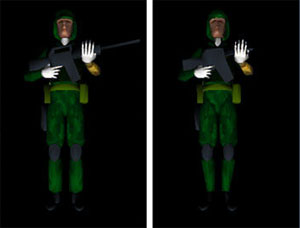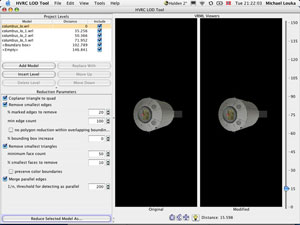| Product Info |
| What is LOD Tool
What's New Licensing |
What is the HVRC LOD Tool?
- Supports creation of ISO VRML97 geometry files
- Provides polygon reduction functionality for simplification of geometry
- Provides level-of-detail editing and generation functionality
- Can be run interactively or in batch mode
The Concept
Virtual reality technology enables users to interact with a simulated environments. A number of issues contribute to making the experience realistic, including the quality of the graphics, the response speed, the behaviour of the environment and objects in it, and the interaction techniques employed. However, the larger and more detailed a model is, the slower the system response time when it is rendered, typically resulting in an unsatisfactory interactive experience.
 By taking into account the way in which users perceive visual objects in a virtual environment, this trade-off can be optimised to enhance the user experience by reducing the amount of detail shown when the user is unlikely to be able to perceive any difference between the reduced model and the original full-detail model. To this end, a set of graphical representations can be stored to represent each 3D object. The run-time system that renders the virtual environment can then choose between detailed or simplified representations depending on some predefined criteria, such as distance, size or relative velocity. This concept is called level of detail (LOD). Using LOD techniques reduces latency in the rendering process and thus improves the system responsiveness, giving the user a more comfortable experience with better ability to interact effectively with the model.
By taking into account the way in which users perceive visual objects in a virtual environment, this trade-off can be optimised to enhance the user experience by reducing the amount of detail shown when the user is unlikely to be able to perceive any difference between the reduced model and the original full-detail model. To this end, a set of graphical representations can be stored to represent each 3D object. The run-time system that renders the virtual environment can then choose between detailed or simplified representations depending on some predefined criteria, such as distance, size or relative velocity. This concept is called level of detail (LOD). Using LOD techniques reduces latency in the rendering process and thus improves the system responsiveness, giving the user a more comfortable experience with better ability to interact effectively with the model.
The simplest and most commonly used LOD selection criteria is distance. The idea behind distance LOD is that an appropriately complex level of detail is selected automatically based on the distance the user is from the object, i.e., the closer the user is to the object, the more detailed the object representation.
The LOD creation process involves replacing a node (a single shape or group of shapes) in a scene graph with a LOD node that encapsulates at least two graphical representations (the LOD node, and a set of nodes containing ordered less detailed representations). The less detailed representations are typically created using simplification techniques such as polygon reduction, or can be individually modelled using a 3D modelling tool. To configure a distance LOD, appropriate distances between levels are selected, typically based on the dimensions of the original object and the level of reduction.
System Overview
 The LOD Tool is a piece of software that can be used to construct level-of-detail data from geometry data in ISO VRML97 format.
The LOD Tool is a piece of software that can be used to construct level-of-detail data from geometry data in ISO VRML97 format.
In its interactive mode, the user can use the LOD tool to generate simplified models, visually check the results of the simplifications, and adjust the distances associated with the varoious reduced models. Models can be sorted and replaced, and the results of model simplifications can be easily compared. Both the LOD configuration for a model and the resulting ISO VRML97 files can be saved.
In batch mode, LODs are either generated completely automatically (probably with varying success) or by using configuration files that control the LOD generation. These are text files that can be configured by hand or be saved as the result of an interactive session.
Credits
The HVRC LOD Tool was originally developed by Lars Beyer-Olsen, Magnus A. Kirstiansen, and Øyvind Liland at Halden Virtual Reality Centre as their third year project while they were students at Østfold University College in 2002. The project proposal and user requirements were written by Michael Louka of HVRC, who was also their project supervisor. The software has since been modified and updated by Michael Louka. For additional credits, please see the Credits informaiton in the Tool's about box.
The HVRC LOD Tool uses the 'reduction chisels' of the software package Chisel developed by Trapezium Software LLC to provide model simplification functions. Thanks to the developers of Chisel for making this software available for use in projects such as thus via the Web3D Consortium.
